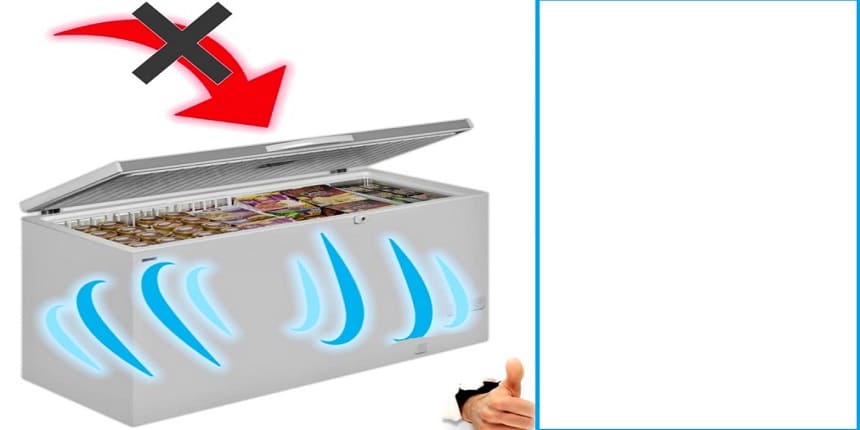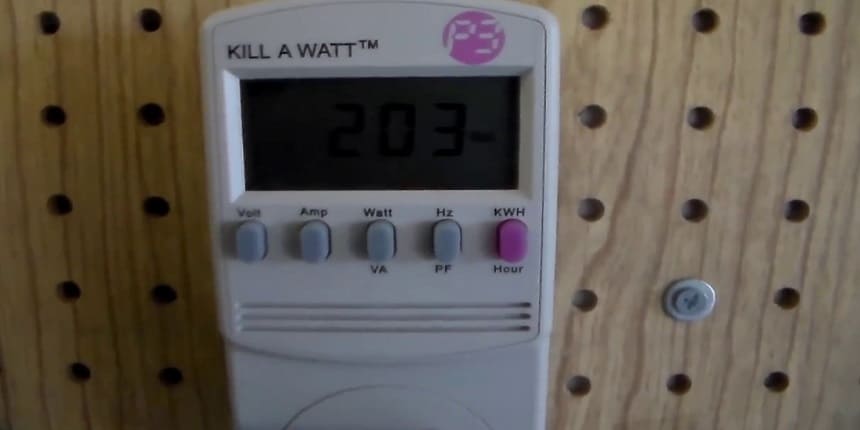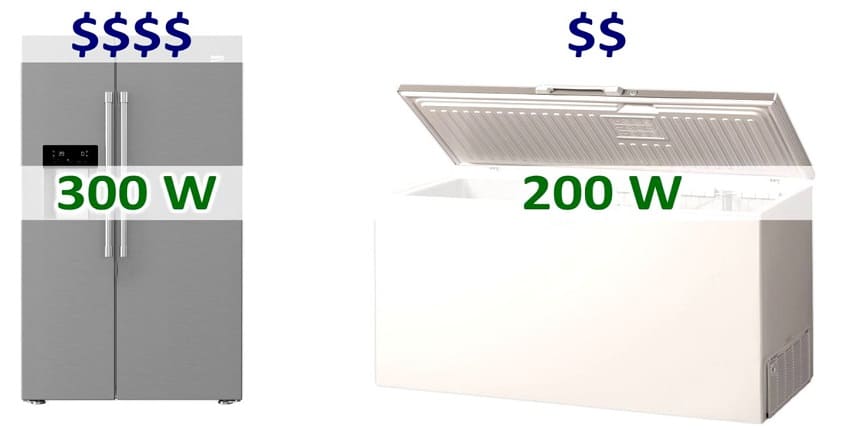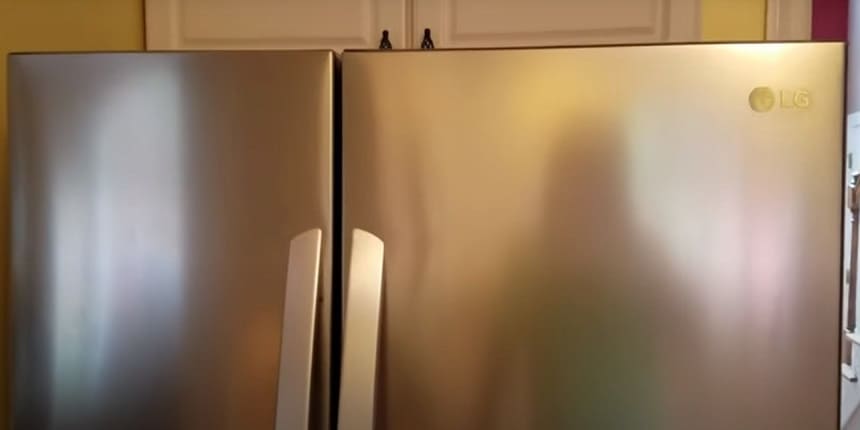An old freezer typically uses around 1-2 kWh of electricity per day. If you have an old freezer, it’s important to be aware of its energy consumption.
Understanding how much electricity it uses per day can help you make informed decisions about energy usage and potentially save on your utility bills. Let’s explore the factors that influence an old freezer’s electricity consumption and some tips for optimizing its energy efficiency.
By the end of this article, you’ll have a clearer understanding of how much electricity an old freezer uses per day and how you can minimize its energy consumption.
Factors Affecting Electricity Consumption In Old Freezers

Old freezers consume varying amounts of electricity depending on several factors.
#1: First, the age and efficiency of the freezer play a significant role. Older freezers tend to be less energy-efficient, resulting in higher electricity use.
#2: Second, the size and storage capacity of the freezer affect its energy consumption. Larger freezers require more energy to cool the additional space.
#3: Third, the frequency of opening and closing the freezer door also impacts energy usage. Each time the door is opened, cold air escapes, causing the freezer to work harder to maintain the desired temperature.
Measuring Power Consumption Of An Old Freezer
Understanding electricity usage metrics can be crucial when assessing the energy consumption of an old freezer.
Calculating energy consumption in kilowatt-hours (kWh) provides insight into the power usage of the appliance over time.
Various tools and devices are available for measuring power consumption, allowing homeowners to track and manage their electricity usage effectively.
How Many kWh Does An Old Freezer Use? – Old Chest Freezer Energy Consumption
Depending on their type and usage patterns, old freezers vary in power consumption.
Chest freezers typically consume less energy compared to upright freezers due to their insulation. Assessing usage patterns and environmental factors, such as location and ambient temperature, also plays a crucial role in determining the daily electricity consumption of an old freezer.
Additionally, conducting a cost analysis of energy consumption can help in understanding the financial impact of using an old freezer daily.
| Freezer Type | Power Consumption (kWh/day) |
|---|---|
| Chest Freezer | 1.2 kWh/day |
| Upright Freezer | 1.8 kWh/day |
Tips For Reducing Electricity Consumption In Old Freezers
Old freezers can consume a significant amount of electricity per day, contributing to high energy bills. However, there are several tips that can help reduce electricity consumption in old freezers.

#1: Temperature Settings and Energy Saving Features
Adjusting the temperature settings to the recommended levels can save energy. It is advisable to set the freezer temperature between 0 and 5 degrees Fahrenheit (-18 to -15 degrees Celsius).
Old freezers may not have built-in energy-saving features, but check if they have features like power-saving mode or energy-efficient compressors.
#2: Proper Placement and Ventilation for Optimal Efficiency
Place the freezer away from heat sources, such as stoves or direct sunlight, to reduce the workload on the appliance. Ensure that there is ample space around the freezer for proper ventilation.
Dust or debris on the condenser coils can decrease efficiency, so periodic cleaning is necessary.
#3: Organizing Food Items to Maximize Energy Saving Benefits
Properly organize the food items in the freezer to maximize energy savings. Avoid overpacking the freezer as it restricts the airflow and makes the appliance work harder.
Similarly, regularly defrost the freezer to maintain its efficiency.
Additional Factors To Consider On How Much Electricity Does a 30 Year Old Freezer Use
When considering the energy consumption of an old freezer, there are additional factors that play a role apart from its age.
# 1: Frost build-up and defrosting techniques are important factors to consider. Frost build-up can increase energy usage significantly, as it reduces the efficiency of the freezer. Regular defrosting is necessary to prevent excessive frost accumulation.
# 2: Proper maintenance and upkeep are also crucial in optimizing energy usage. Keeping the freezer clean and ensuring proper airflow can help improve efficiency.
# 3: Upgrading to energy-efficient models is another option to consider. Newer models are designed to consume less electricity while providing the same level of cooling.

By taking these factors into account and making informed decisions, it is possible to minimize the electricity consumption of an old freezer and save on energy costs.
How Many Watts Does a Freezer Use Per Day – How Much Electricity Does an Old Freezer Use Per Day [Comparing]
Comparing old and new freezer models in terms of electricity consumption reveals significant advancements in technology for energy efficiency. Upgrading to a new freezer not only brings cost and energy savings but also has a positive environmental impact.
The old freezer models tend to consume more electricity compared to the newer ones.
This is primarily due to the technological improvements in energy efficiency. Newer freezers are equipped with features such as better insulation, improved compressor efficiency, and advanced temperature control mechanisms.
These advancements ensure lower electricity consumption, resulting in reduced energy costs.
With a new freezer, users can experience substantial cost savings over time. The electricity savings can add up significantly, especially for those who use their freezer on a daily basis.
Furthermore, the environmental impact of older freezers is a concern. Older models may use outdated refrigerants that can contribute to greenhouse gas emissions.
Newer freezers, on the other hand, are designed to meet stringent energy efficiency regulations, reducing their overall environmental footprint.

The End
To sum up, understanding the electricity consumption of an old freezer is crucial for both cost savings and environmental reasons.
By identifying the wattage and calculating the daily usage, you can make informed decisions to reduce energy waste.
Consider replacing outdated models with energy-efficient alternatives, implementing simple habits like regular defrosting and proper temperature maintenance, and finally, recycling or donating old appliances.
By taking these steps, you can contribute to a more sustainable future while saving on your electricity bills.
